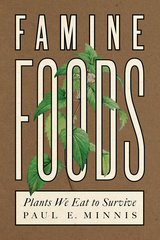
232 pages, 5 1/2 x 8 1/2
111 b&w photos, 6 tables
Paperback
Release Date:22 Oct 2024
ISBN:9780816553754
Hardcover
Release Date:22 Oct 2024
ISBN:9780816553761
Plants for Desperate Times
The Diversity of Life-Saving Famine Foods
By Paul E. Minnis and Robert Freedman
The University of Arizona Press
Famines and other serious food shortages have been one of the scourges faced by humanity for millennia.
Plants for Desperate Times is an introduction to the diversity of plant foods that have saved millions of lives during lethal food shortages. While not a field guide, it addresses questions about what famine foods are and why they are important. The work highlights one hundred plants. Each entry includes the common and scientific names, botanical family, distribution, use as a famine food and other uses, and nutritional information. The species come from across the botanical kingdom, demonstrating the diversity of life-saving plants and the human ingenuity of making what might seem to be inedible plants edible. Unexpectedly, important famine foods include alternative uses of important crops as well as native plants.
Beyond a study of famine foods, the authors share why keeping an inventory of plant foods of last resort is so important. They help to build an understanding of little-known and underappreciated foods that may have a greater role in provisioning humanity in the future. As much as we may hope that severe food scarcity will never occur again, history suggests otherwise, and Plants for Desperate Times provides invaluable documentation of these vital foods.
Plants for Desperate Times is an introduction to the diversity of plant foods that have saved millions of lives during lethal food shortages. While not a field guide, it addresses questions about what famine foods are and why they are important. The work highlights one hundred plants. Each entry includes the common and scientific names, botanical family, distribution, use as a famine food and other uses, and nutritional information. The species come from across the botanical kingdom, demonstrating the diversity of life-saving plants and the human ingenuity of making what might seem to be inedible plants edible. Unexpectedly, important famine foods include alternative uses of important crops as well as native plants.
Beyond a study of famine foods, the authors share why keeping an inventory of plant foods of last resort is so important. They help to build an understanding of little-known and underappreciated foods that may have a greater role in provisioning humanity in the future. As much as we may hope that severe food scarcity will never occur again, history suggests otherwise, and Plants for Desperate Times provides invaluable documentation of these vital foods.
This is a detailed dive into plant-based famine foods long utilized by cultures from around the world both historically and more recently. Every student of ethnobotany, economic botany, and environmental anthropology should have a copy of this book written by two highly regarded scholars in the field of ethnobotany.’—Enrique Salmón, author of Eating the Landscape:American Indian Stories of Food, Identity, and Resilience
‘This book is a truly unique reference guide to the often unusual and yet essential foods that humankind has relied on for survival in times of starvation.’—Kara Rogers, author of The Quiet Extinction:Stories of North America’s Rare and Threatened Plants
‘This guide to the diversity of human foodways in times of exigency is essential reading as we reckon with the potential food shortages incurred by global climate change, conflict, and inequality. Minnis and Freedman’s tour of little-known plant foods is a vital contribution to imagining future foodways.’—Courtney Fullilove, author of The Profit of the Earth:The Global Seeds of American Agriculture
Paul E. Minnis is a professor emeritus of anthropology at the University of Oklahoma now living in Tucson, Arizona, where he is a visiting scholar in the School of Anthropology at the University of Arizona. He is the author or editor of fifteen books, including Famine Foods: Plants We Eat to Survive, and numerous articles.
Robert L. Freedman received a BA in Oriental studies and cultural anthropology from the University of Arizona. In 1996, Freedman created The Famine Foods Database, which is hosted by Purdue University’s New Crops website.
Robert L. Freedman received a BA in Oriental studies and cultural anthropology from the University of Arizona. In 1996, Freedman created The Famine Foods Database, which is hosted by Purdue University’s New Crops website.














